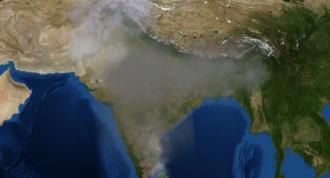
In a recent finding that could unveil a hitherto unknown function of the South Asian monsoon, researchers from Germany and Cyprus have described how the South Asian monsoon plays an active role in regulating the levels of pollutants in the atmosphere. While we knew that the monsoon rains brought a much-needed relief during the hot summer months, and fuelled our agriculture activities, this discovery could help understand the implications of monsoon on the pollutants in the atmosphere.
The word ‘monsoon’, derived from the Arabic word mausam or season, is a seasonal change in the direction of the prevailing winds in a region. The South Asian summer monsoon is marked by heavy rainfall during the months of May-September, followed by a dry winter monsoon. Although we knew about the winter haze or ‘atmospheric brown cloud’ that formed due to vehicular emissions and crop burning, there was no explanation for the disappearance of the haze when the rainy summer monsoon arrived, until now.
In the current study, published in the journal Science, the researchers conducted an elaborate experiment to explore the reasons behind this phenomenon. They studied and measured atmospheric pollutants using a High Altitude and Long Range research aircraft (HALO) at an altitude of 9-15 km during July and August 2015. They analysed their measurements by combining it with computer models for air circulation and tracked the path and fate of the pollutants.
The researchers found that the South Asian monsoon acted as a natural air purifier. The rains removed a considerable fraction of the pollutants and their oxides. For example, nearly 80% of the reactive sulphur emissions in South Asia were found to be removed by precipitation. However, on the flip side, the researchers found that the monsoon was responsible for spreading the pollutants from South East Asia to all over the world.
So, how does the cleaning action of the monsoon work? Above the stormy monsoon clouds, there exists a region of high atmospheric pressure called the anticyclone. When large amounts of pollutants in the atmosphere reach this layer, they are distributed globally.
“South Asian emissions dominate pollution concentrations in the anticyclone. Once in the upper troposphere, in the absence of deposition processes, pollutants accumulate and are chemically processed in a reactive reservoir for weeks to more than a month, from where carbonaceous, sulphur, nitrogen and halogen-containing reaction products disperse globally”, explain the authors.
Pointing out the two opposite roles of the South Asian monsoon, the researchers say, “the monsoon has two faces, like a Janus’ head—transferring pollutants from the surface upward while sustaining an effective cleansing mechanism that curbs the impacts.” With the burden of pollutants proliferating, the researchers believe that the South Asian emissions will intensify the flux of pollutants through the anticyclone in the years to come.






